- MOE
- National Parks of Japan
- Minami Alps National Park
- Characteristics
main body

Characteristics
Lofty Summits Engraved with the Memories of the Seabed
—Enveloped in a deep forest, a chain of massive mountains that still continues to rise even now
—Enveloped in a deep forest, a chain of massive mountains that still continues to rise even now
Date of Designation: June 1, 1964
Area: 35,752 ha
Related Prefecture: Yamanashi, Nagano, Shizuoka
Area: 35,752 ha
Related Prefecture: Yamanashi, Nagano, Shizuoka
The Minami Alps consist of three mountain ranges: the Kaikoma and Hoo Mountains, Shirane Mountains, and the Akashi Mountains and is home to the nation's second tallest mountain, Mt. Kitadake (3,193 m above sea level) and more than ten 3,000 m class mountains while the headstream of the Oi River, Tenryu River, and Fuji River are found in the midst of the mountains. As the mountains lie on the southernmost point among the Japan Alps, the area receives much rain in the summer and less snow in the winter. It is also characterized by a number of deep V-shaped valleys formed by river channel erosion due to abundant rainfall, and owing to a light snowfall, the altitude of the timberline is high and the vicinity of the ridges are covered in forests.
The Minami Alps are noted for the trace remnants of Japan's southernmost glacier, and there are glacial landforms and periglacial landforms in existence over the alpine belt, which were formed about 20,000 years ago. The cirques (kar) remained in the Mt. Senjogatake, and the Arakawasanzan is one of the cirques. The fauna and flora include rock ptarmigan , Callianthemum hondoense, Dryas octopetala and alpine butterflies that expanded their distribution during the ice age and survived even now. In addition, the Minami Alps have been traditionally regarded as the place of mountain worship since days of old, making it a valuable area not only for its natural environment but also for the inheritance of culture.
The Minami Alps are noted for the trace remnants of Japan's southernmost glacier, and there are glacial landforms and periglacial landforms in existence over the alpine belt, which were formed about 20,000 years ago. The cirques (kar) remained in the Mt. Senjogatake, and the Arakawasanzan is one of the cirques. The fauna and flora include rock ptarmigan , Callianthemum hondoense, Dryas octopetala and alpine butterflies that expanded their distribution during the ice age and survived even now. In addition, the Minami Alps have been traditionally regarded as the place of mountain worship since days of old, making it a valuable area not only for its natural environment but also for the inheritance of culture.
Terrain/ Scenery

The Magnificent Mt. Ainodake and the Valley on the South Face
The Minami Alps are characterized by the geographical feature called a tectonic hill and the massive appearance, consisting of non-volcanic mountains that rapidly elevated as a result of pressure in the east-west direction, which occurred one million years ago. Also, the Minami Alps are still rising even now by the speed of 3 to 4 mm annually, indicating the fastest uplift rate in Japan, as well as the world's one of the fastest.
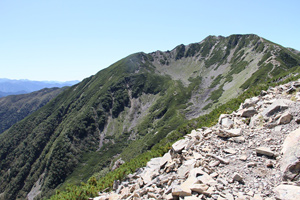
Kosenjo Kar
Other features are the cirques formed by a glacier and many periglacial landforms created by repeated freezing and melting resulting in patterned grounds.
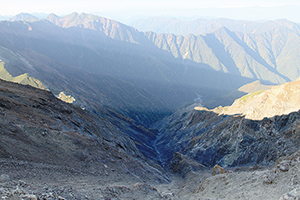
A Denuded Land of Mt. Arakawa-Maedake
When the mountain rises rapidly, the ridgelines and hillslopes easily collapse, and added to which, affected by the humid and pluvial climate unique to the Minami Alps area, the valleys become deeply eroded.
As a result, the area has numerous V-shaped valleys, linear depressions, and landslide scars.
As a result, the area has numerous V-shaped valleys, linear depressions, and landslide scars.
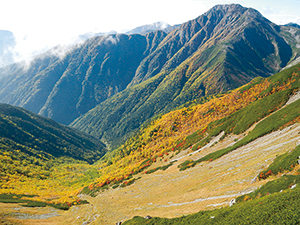
V-shaped Valley in Mt. Akaishi
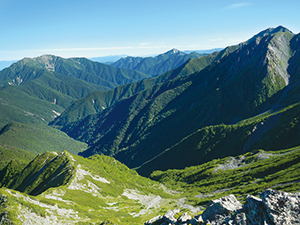
The Headwater of the Noro River, Viewed from Mt. Mibudake
The forests of the Minami Alps are marked by the timberline (about 2,700 m above sea level) due to the climate and geological conditions. The mountains are covered in forests at high altitude. Also, the area features a clear vertical distribution of forests from the hilly zone at below 800 m above sea level to the alpine belt.
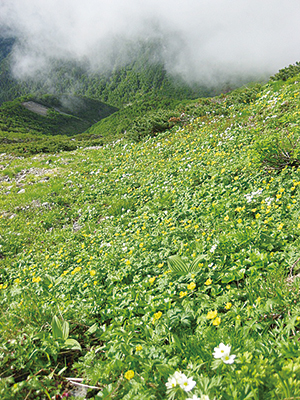
Alpine meadows in Mt. Arakawa
At the timberline at near 1,600 m above sea level are stands of broadleaf forest including Japanese beech trees, and above 2,700 m elevation in the subalpine belt are a coniferous forest consisting of the Abies veitchii, while above which in the alpine belt are the creeping pine zone and numerous flowering alpine meadows.
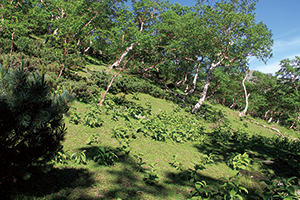
Erman's Birch Forest in the Subalpine Belt
The adjacent to the boarder of the alpine belt and subalpine belt is a forest of Erman's Birch trees.
The mountain ridges of the Minami Alps are the best place to gaze upon beautiful alpine meadows in a backdrop of imposing mountains.
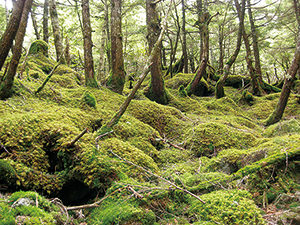
A Forest Floor Overgrown with Moss
Plants
The Minami Alps are home to wildlife that expanded its range during the ice age and survived the process of rising temperature in a low-temperate high mountain zone (the relict species from the ice age). The alpine floras grow here include Callianthemum hondoense, Dryas octopetala, Silene uralensis (Rupr.) Bocquet, Saxifraga ceruna, and some alpine species growing in a high-mountain area are the relict species from the ice age.
Other types of endemic species include Silene keiskei var. akaisialpina, Ranunculus kitadakeanus and Comastoma pulmonarium subsp. Sectum, which are indigenous plants found nowhere else but the Minami Alps and their surrounding areas.
Other types of endemic species include Silene keiskei var. akaisialpina, Ranunculus kitadakeanus and Comastoma pulmonarium subsp. Sectum, which are indigenous plants found nowhere else but the Minami Alps and their surrounding areas.
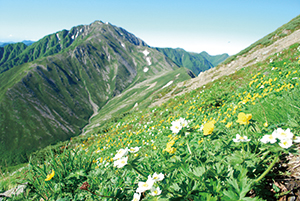
The Southeastern Slope of Mt. Arakawa-Maedake Covered with Alpine Meadows and Mt. Akaishi
Wildlife
Thanks to the remnants of deep and primeval forests, the fauna and flora of the Minami Alps abound with a large variety of mammals, and more than 30 species have been confirmed, including Asian black bear, Japanese serow, Vulpes vulpes japonica, Japanese macaque and the Jananese stoat.
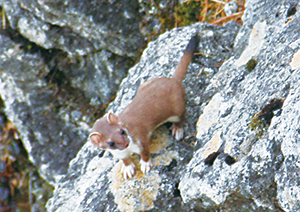
Jananese Stoat (Small Carnivorous Mammals Inhabiting in the Mountainous Area)
By contrast, the representative bird observed here is rock ptarmigan, which is designated as a nationally protected species by the government: rock ptarmigan makes its nest in the alpine belt and its southern limit is the Mt. Tekari. There are also large varieties of insects in response to the rich nature environment, as well as alpine butterflies.
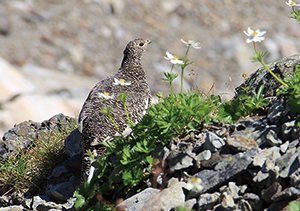
Rock Ptarmigan
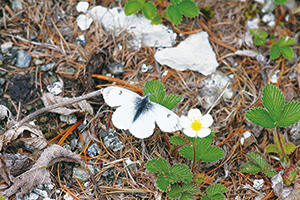
Anthocharis cardamines niphonica (a Natural Monument designated by Nagano Prefecture)
Culture
While being a secluded, profound natural region, the mountains of the Minami Alps have been traditionally worshiped as a sacred mountain and deeply connected to people's lives.
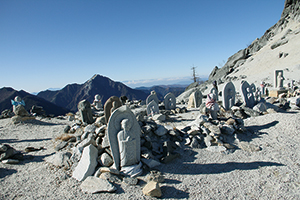
Mt. Jizogatake
The Legendary Jizo of Infertility
Traditionally, to wish for a child and infertility, a husband and wife climb the Mt. Jizogatake (Hoo Sanzan Mountains) and bring back a Jizo statue, and after their wish came true, they return to the mountain with two Jizo statues in return.

Daijojidaira Plateau
The Mountain Path to Worship the Sacred Sites
Long ago, the mountain path extending from Oshika Village through the Koshibu River to the Daijoji-daira Plain was said to open so as to worship Mt. Ontake situated far in Kiso.
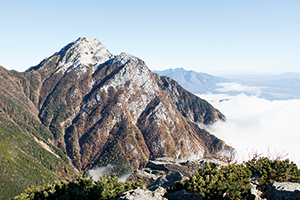
Mt. Kai-komagatake, Viewed from the Mt. Kurisawa
Worship of the Mt. Komagatake
The Mt. Kai-komagatake (Mt. Higashi-komagatake) opened to the public from the Kuroto-One on the side of Hokuto City at the end of Edo era in the 1800s. Based in the Komagatake-jinja Shrine at the foot, the meetings for the purpose of spiritual activities were carried out proactively, and even today, the tradition of spiritual mountain climbing has been handed down and the members dressed in white clothing visit the Komagatake-jinja Shrine while reading the Heart Sutra heading to reach the summit.
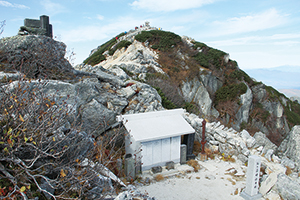
The vicinity of the Summit of Mt. Kai-komagatake(Komagatake-jinja Shrine Headquarters)
